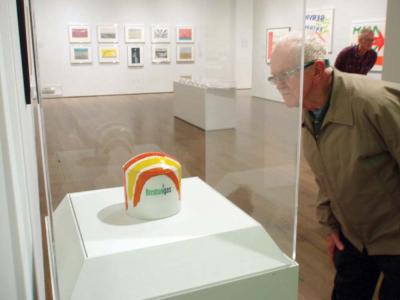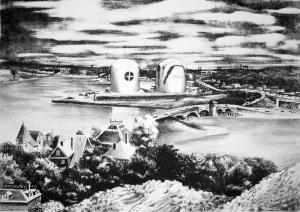October 8, 2015
 From the bog to the Fogg: A replica of Corita Kent’s “Rainbow Swash,” preserved inside a vitrine as part of the exhibition, “Corita Kent and the Language of Pop,” on view at the Harvard University Fogg Museum until Jan. 3, 2016. James Hobin photo
From the bog to the Fogg: A replica of Corita Kent’s “Rainbow Swash,” preserved inside a vitrine as part of the exhibition, “Corita Kent and the Language of Pop,” on view at the Harvard University Fogg Museum until Jan. 3, 2016. James Hobin photo
One Saturday morning last month, I took the train to Harvard Square and headed for the Fogg Museum and an art exhibition entitled, “Corita Kent and the Language of Pop.” Corita Kent, a onetime Roman Catholic nun, was the artist who painted six giant stripes over the top and sides of the Boston Gas tank on Morrissey Boulevard back in 1971.
As I made my way past the tourists bustling about Harvard Yard, I recalled the first time that I had seen the tank’s stripes and heard about the woman who had put them there. Those messy brushstrokes were a challenge to my sense of order, and the fact that a former nun was responsible added a layer of complexity that was beyond my understanding. It turns out that this was my first encounter with modern art.
As a parochial school student, I knew nuns to be strict and fastidious, so I expected that a nun, even a former one, would stay “in the lines” while painting, but this tank looked as if it had been crayoned by a naughty child. I was in the fifth grade at the time, and though already wearing bell bottom pants, I was still too young to know that the tank’s design was a novelty of the swinging sixties, the decade when lots of people, including some nuns, were letting it all hang out.
The tank is located at Commercial Point, on a spit of land at the end of Victory Road. The gas company has a history on this shoreline, which has been almost entirely reclaimed by landfill, beginning in the late 1870’s, when the Boston Gas Light Company filled in the northeast tip of the point. In 1907, the state deepened the channel to the wharves on the north side of Freeport Street, depositing dredged material onto the gas company’s property. In 1917, the property expanded again, with the filling of Tenean Creek.
I remember the old tank, a great hulk nicknamed “the Gray Lady.” It rose and fell as the content was pumped in and out, moving like a giant balloon. That tank was demolished around 1970, and replaced with two smaller tanks. The first tank was branded with the Boston Gas logo, the second tank was covered with Corita’s stripes.
 “View from Savin Hill, 1992” showing Dorchester Bay with two gas tanks on Morrissey Boulevard near the Southeast Expressway. Lithograph by James Hobin
“View from Savin Hill, 1992” showing Dorchester Bay with two gas tanks on Morrissey Boulevard near the Southeast Expressway. Lithograph by James Hobin
Twenty years later, only one tank was needed, and Corita’s tank was slated for destruction. The demolition crew attempted to remove the roof in the manner of peeling the lid off a tin can, but the weight of the roof was too much and it caved in, making an explosion of noise that rattled everybody within hearing distance. Nevertheless, the removal was completed, and the stripes were re-painted on the one remaining tank. With the tank’s height at 150 feet, Corita’s design, entitled, “Rainbow Swash,” is the largest copyrighted work of art in the world.
I once saw a television program about the paint job that showed men in white overalls perched on swing staging, plying enormous brushes. As a reference, they each held a small-scale model of the tank, complete with Corita’s stripes and signature. It’s amazing how accurate they were in reproducing every nuance of the original design, including the blue stripe, made famous for being seen as a facsimile of the profile of Ho Chi Minh. Or is it Ho Chi Minh? Corita’s answer to this question is not on record.
Corita was born Frances Elizabeth Kent in Iowa in 1918. In 1936, she moved to Los Angeles and entered the order of the Sisters of the Immaculate Heart of Mary, taking the name Sister Mary Corita. At Immaculate Heart College, as dean of the art department, she was known to attract the avant-garde, including students such as Alfred Hitchcock, Buckminster Fuller, and John Cage.
In 1962, Corita saw an exhibition of Campbell’s soup cans by Andy Warhol and decided to change her style. She abandoned standard religious subject matter and adopted the pop art idiom, using only abstract shapes and commercial media imagery. Her specialty became brightly colored silkscreen prints, in which broad, gestural brushwork is juxtaposed with layers of printed text.
At the Fogg exhibition, Corita’s screenprints are displayed side by side with Warhol’s soup can and other exemplars of pop art. Pop artists wanted to elevate everyday objects to a level of the sublime. Corita may have employed pop art’s strategies, but she wasn’t considered a full-fledged pop artist. In the selection of her prints on display, done between 1964 and 1969, what is most evident is her devotion to her own religious values. One series of prints was inspired by samples of food packaging available at the supermarket. For instance, she used the Wonder Bread package design as a resource for images based on the theme of the Eucharist.
Corita’s credentials as an activist are established by another series of prints that focuses on civil rights, poverty, and the Vietnam War. She committed her time and artistic skills to create propaganda posters for political causes and the anti-war movement. These prints are emblazoned with phrases like “Black is Beautiful, “Stop the Bombing,” and “Love your Brother.”
The Second Vatican Council may have helped direct Corita’s move toward radicalism. The council brought major reforms to the church, including allowing nuns to wear secular clothes. But kicking the habit was not enough, it seems that Corita’s mission demanded more. In 1968, she left the order and moved to Boston.
Three years later, Corita accepted a commission for a design on the new Boston Gas tank, and now we can’t conceive of Dorchester without it. Whoever thought that an artist could make people fall in love with a gas tank? The genius of the design is that she alters our sense of scale, making the tank appear to be smaller in contrast to the proportionally oversized brushstrokes.
There may be other reasons why people are attracted to her artwork. At the Fogg, Corita’s original painted scale-model tank is preserved inside a vitrine; the attached text includes this sentence: ‘The tank’s rainbow motif offers a secular take on a passage from Genesis, in which God vows to “put a bow in the sky” as a symbol of the covenant with humanity.’



